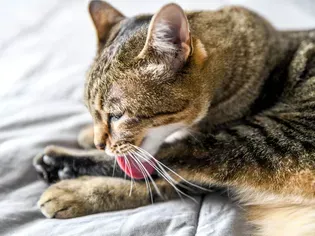Reasons Why Cats Overgroom and How to Stop It
Updated on 04/26/24

Why Your Cat Is Overgrooming and How to Stop It
Overgrooming, also known as psychogenic alopecia, is a common problem in cats. It can be caused by a variety of factors, including stress, anxiety, boredom, and medical conditions. While overgrooming is not always harmful, it can lead to skin irritation, hair loss, and other health problems.
Signs of Overgrooming
* Excessive licking or chewing at the fur
* Hair loss in patches or clumps
* Redness or irritation of the skin
* Scabs or crusts on the skin
* Biting or scratching at the skin
Causes of Overgrooming
* Stress or anxiety: Cats are sensitive creatures and can be easily stressed by changes in their environment, such as moving to a new home, the addition of a new pet, or a change in their routine. Stress can lead to overgrooming as a way to self-soothe.
* Boredom: Cats who are bored or understimulated may overgroom as a way to entertain themselves. This is especially common in cats who are kept indoors without much to do.
* Medical conditions: Some medical conditions, such as allergies, skin infections, and parasites, can cause itching and irritation, which can lead to overgrooming.
How to Stop Overgrooming
The best way to stop overgrooming is to address the underlying cause. If your cat is stressed, try to identify and eliminate the source of stress. If your cat is bored, provide them with more toys and activities to keep them entertained. If your cat has a medical condition, consult with your veterinarian for treatment.
In addition to addressing the underlying cause, there are a few things you can do to help stop your cat from overgrooming.
* Provide a calming environment: Create a safe and comfortable space for your cat where they can relax and feel secure. This may include providing them with a hiding place, such as a cat bed or a cardboard box.
* Offer plenty of toys and activities: Keep your cat entertained with a variety of toys, such as interactive toys, puzzle feeders, and scratching posts. This will help to prevent them from getting bored and overgrooming.
* Brush your cat regularly: Brushing your cat's fur regularly will help to remove loose hair and prevent mats, which can be irritating and lead to overgrooming.
* Avoid punishment: Never punish your cat for overgrooming. This will only make the problem worse.
When to See a Veterinarian
If your cat is overgrooming and you are unable to stop it on your own, it is important to consult with your veterinarian. Your veterinarian will be able to rule out any underlying medical conditions and recommend the best course of treatment.
Examples of Overgrooming
* A cat who has been declawed may overgroom the paws and feet to compensate for the lack of claws.
* A cat who has been separated from its littermates or mother may overgroom as a way to comfort itself.
* A cat who is living in a stressful environment, such as a home with multiple cats or a noisy neighborhood, may overgroom as a way to cope with the stress.
Conclusion
Overgrooming is a common problem in cats, but it can be stopped with the right treatment. By identifying and addressing the underlying cause, providing a calming environment, and offering plenty of toys and activities, you can help your cat stop overgrooming and live a happy and healthy life.
Explore More Pets

Cat Behavior Problems
How to Stop Aggression in Kittens

Long-Haired Cat Breeds
Siberian Cat: Breed Profile, Characteristics, & Care

Cat Behavior Problems
How to Stop Kittens From Scratching and Biting

Long-Haired Cat Breeds
Turkish Angora: Cat Breed Profile, Characteristics & Care

Basic Training
How to Socialize Your Kitten

Short-Haired Cat Breeds
Cute Pictures & Facts About Calico Cats & Kittens

Litter Box Training
Training Your Kitten to Use the Litter Box

Long-Haired Cat Breeds
10 Fun Facts About White Cats